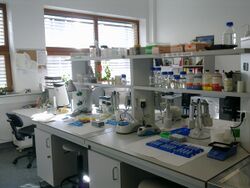Reference laboratory
A reference laboratory is a laboratory which is accredited either at the national level (NRL) or at the supranational level (SNRL),[1] for its ability and its accuracy. Examples are: biological,[2] chemical, engineering, human food safety, animal feed testing,[3] geological, health,[1] metrological or nuclear. Governments need to control according to standards, like the International Standards Organization, the American National Standards Institute or the GOST. The standard, and the human resources to test for that standard are warehoused in reference laboratories.
Synopsis
Use of the term was established prior to 1994, when The Australian Enterovirus Reference Laboratory was commissioned in Melbourne as part of the WHO programme for the global eradication of poliomyelitis.[4] In fact, the Pan-American Health Organization set one up in 1980 for medical mycology.[5]
In 2021, there were 264 World Organization for Animal Health (OIE) Reference Laboratories for animal health covering 109 diseases or topics in 37 countries and 65 Collaborating Centres in 31 countries.
Since 2010, the World Health Organization (WHO) has been home to a Global Health Observatory which depends for the collection of its statistics on the individual NRL, each of which is required "to implement quality assurance and, in many cases, is the main facility where testing for resistance to first and second-line drugs is done. The NRL also interacts with the SNRL. All countries should have a NRL."[1] In fact, this pronouncement was the impetus behind the 2010 effort to create a NRL in Afghanistan after the country was left devastated by the Islamic Emirate of Afghanistan (1996–2001), subsequent United States invasion of Afghanistan and formation of the Islamic Republic of Afghanistan,[6] which dominated politics in the country until August 2021.
The WHO noticed early on that the International Health Regulations (2005) was unclear on the reference laboratory question, and so it issued documents such as "Laboratory Capacity Requirements for International Health Regulations and their Implementation in the WHO African Region" in which NRLs figured prominently.[7]
As of April 2022 the Vector Institute is the Russian site for the WHO H5 Reference Laboratory Network, which responds "to the public health needs arising from avian influenza A(H5N1) infection in humans and influenza pandemic preparedness."[8]
The Istituto Zooprofilattico Sperimentale delle Venezie (IZSVe) was in 2022 the Italian National Reference Centre for seven categories of biology including avian influenza, Rabies, Salmonellosis and Beekeeping. The IZSVe was in 2022 an International Reference Laboratory for the European Union, the Food and Agriculture Organization, and the OIE.[9] As of April 2022, the Robert Koch Institute in Berlin was the WHO Regional Reference Laboratory for poliomyelitis, measles and rubella.[10]
The European Union Reference Laboratories, which were structured by Commission Regulation (EC) No 776/2006 and Commission Regulation (EC) No 882/2004, are a European Union effort to standardize reference labs across 27 nations.[11] The Commission "is empowered to establish EU Reference Laboratories (EURLs) in those sectors where there is a recognised need to promote uniform practices and reliability of methods of analysis, tests and diagnosis."[12] The regulations were updated by Regulation (EU) No 2017/625 on 29 April 2018.[13] In the EU context, "the national reference laboratory is the leading laboratory in the state which in the specific area official testing has been nominated in accordance with the requirements of EU and national legislation."[14]
In the United Kingdom , the Food Standards Agency largely focuses on microbial or chemical causes of illness that is ingested, and has separate NRLs for each cause.[3]
The United Arab Emirates NRL boasts that it can perform more than 4,700 biological tests in Allergy, Anatomic Pathology, Cardiovascular Disease, Coagulation, Dermatology, Endocrinology, Gastroenterology, Genetics, Hematology, Infectious Diseases, Medical Drug Monitoring, Microbiology, Obstetrics and Gynecology and Oncology.[15]
The WHO used BSL3 ISO 15189-certified reference laboratories for confirmatory testing for COVID-19 as early as April 2020. Countries which have no testing capacity and national COVID-19 laboratories with limited experience on COVID-19 virus testing were encouraged to send the first five positives and the first ten negative COVID-19 samples to WHO reference laboratories, which provided confirmatory testing for COVID-19.[16]
References
- ↑ 1.0 1.1 1.2 "National Reference Laboratory (NRL)". World Health Organization. n.d.. https://www.who.int/data/gho/indicator-metadata-registry/imr-details/1373.
- ↑ "Reference Laboratories". OIE World Organization for Animal Health. n.d.. https://www.oie.int/en/what-we-offer/expertise-network/reference-laboratories/.
- ↑ 3.0 3.1 "Food Standards Agency > About us > National Reference Laboratories (NRLs)". Food Standards Agency. 7 February 2022. https://www.food.gov.uk/about-us/national-reference-laboratories-nrls.
- ↑ "ENTEROVIRUS REFERENCE". Victorian Infectious Diseases Reference Laboratory. n.d.. https://www.vidrl.org.au/laboratories/poliovirus-reference/.
- ↑ Castañeda, Elizabeth; Ordoñez, N; Guzmán, Miguel (1980). Program for a central reference laboratory for medical mycology. https://iris.paho.org/handle/10665.2/38573?show=full.
- ↑ Chretien, Jean-Paul; Yingst, Samuel L.; Thompson, Donald (September 2010). "Building public health capacity in Afghanistan to implement the international health regulations: a role for security forces". Biosecurity and Bioterrorism: Biodefense Strategy, Practice, and Science 8 (3): 277–285. doi:10.1089/bsp.2009.0058. PMID 20825338. https://link.gale.com/apps/doc/A237534456/AONE?u=anon~c8073712&sid=googleScholar&xid=77b2ea5e.
- ↑ "Laboratory Capacity Requirements for International Health Regulations and their Implementation in the WHO African Region". World Health Organization Regional Office for Africa. 2013. https://www.afro.who.int/publications/laboratory-capacity-requirements-international-health-regulations-and-their.
- ↑ "WHO H5 Reference Laboratories". World Health Organization. n.d.. https://www.who.int/initiatives/global-influenza-surveillance-and-response-system/h5-reference-laboratories.
- ↑ "Reference laboratories". Istituto Zooprofilattico Sperimentale delle Venezie. n.d.. https://www.izsvenezie.com/reference-laboratories/.
- ↑ "WHO Reference Laboratories". Robert Koch Institute. 1 March 2016. https://www.rki.de/EN/Content/Institute/International/reference_labs/ref_lab_node.html.
- ↑ "National Reference Laboratories at the BVL". Federal Office of Consumer Protection and Food Safety. n.d.. https://www.bvl.bund.de/EN/Tasks/09_Laboratories/01_Tasks/02_reference_laboratories/02_reference_laboratories_NRL/reference_laboratories_NRL_node.html.
- ↑ "Reference Laboratories and Centres". Directorate-General for Health and Food Safety. n.d.. https://ec.europa.eu/food/horizontal-topics/official-controls-and-enforcement/legislation-official-controls/reference_en.
- ↑ "European Union Reference Laboratories". Directorate-General for Health and Food Safety. https://ec.europa.eu/food/horizontal-topics/european-union-reference-laboratories_en.
- ↑ "THE NATIONAL REFERENCE LABORATORY". Latvian Institute of Food safety, Animal Health and Environment "BIOR". n.d.. https://bior.lv/en/national-reference-laboratory.
- ↑ "Laboratory Testing". National Reference Laboratory. n.d.. https://www.nrl.ae/en/contents/view/laboratory-testing.html.
- ↑ "WHO reference laboratories providing confirmatory testing for COVID-19". World Health Organization. 19 April 2020. https://www.who.int/publications/m/item/who-reference-laboratories-providing-confirmatory-testing-for-covid-19.


